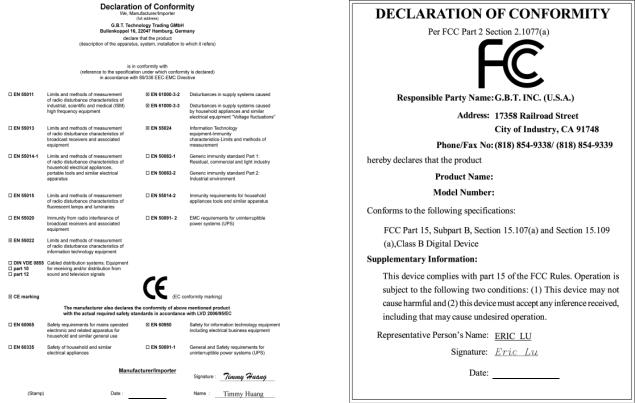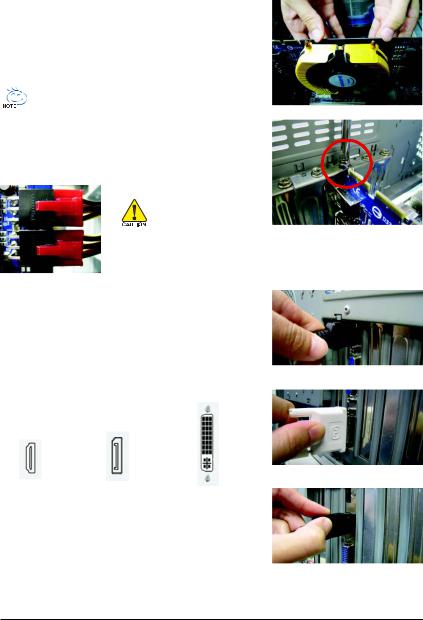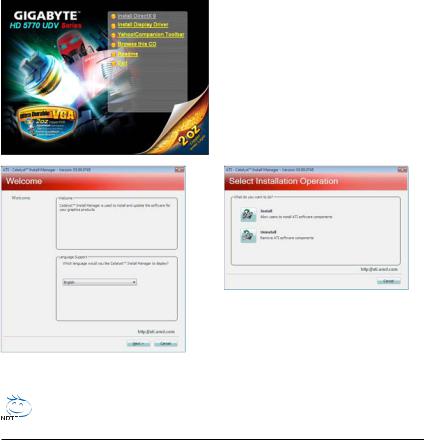GIGABYTE GV-R577UD-1GD Owner's Manual
GV-R577UD-1GD
ATI RadeonTM HD 5770 Graphics Accelerator
User's Manual
Rev. 101
12MM-R577UGD-101R
Copyright
© 2009 GIGABYTE TECHNOLOGY CO., LTD
Copyright by GIGA-BYTE TECHNOLOGY CO., LTD. ("GBT"). No part of this manual may be reproduced or transmitted in any form without the expressed, written permission of GBT.
Trademarks
Third-party brands and names are the properties of their respective owners.
Notice
Please do not remove any labels on this graphics card. Doing so may void the warranty of this card.
Due to rapid change in technology, some of the specifications might be out of date before publication of this this manual. The author assumes no responsibility for any errors or omissions that may appear in this document nor does the author make a commitment to update the information contained herein.
Macrovision corporation product notice:
This product incorporates copyright protection technology that is protected by U.S. patents and other intellectual property rights. Use of this copyright protection technology must be authorized by Macrovision, and is intended for home and other limited viewing uses only unless otherwise authorized by Macrovision. Reverse engineering or disassembly is prohibited.

VGA Card
GV-R577UD-1GD
VGA Card
GV-R577UD-1GD
Dec. 07, 2009
Dec. 07, 2009

|
Table of Contents |
|
1. Introduction ................................................................................................................ |
4 |
|
1.1. Features ......................................................................................................................... |
4 |
|
1.2. Minimum System Requirements .................................................................................... |
4 |
|
2. Hardware Installation .................................................................................................. |
5 |
|
2.1. Board Layout ................................................................................................................. |
5 |
|
2.2. Hardware Installation ...................................................................................................... |
7 |
|
3. Software Installation .................................................................................................... |
8 |
|
3.1. Driver and Utility Installation ........................................................................................... |
8 |
|
|
3.1.1. Driver Installation ........................................................................................................... |
8 |
3.2. |
Taskbar Icon ............................................................................................................. |
10 |
3.3. |
Display Properties Pages ........................................................................................ |
12 |
4. Troubleshooting Tips ................................................................................................ |
25 |
|
5. Appendix ................................................................................................................. |
26 |
|
5.1. Resolutions and Color Depth Tables ............................................................................. |
26 |
|
5.2. Regulatory Statements ................................................................................................. |
27 |
|
- 3 -

1. Introduction
1.1.Features
•Powered by ATI RadeonTM HD 5770 Graphics Processing Unit (GPU)
•Supports PCI Express 2.0
•Integrated with 1 GB GDDR5 memory
•Supports DirectX 11
•Supports CrossFireXTM
•Supports DVI-I / HDMI / Display port
•Supports 2 Dual-Link DVI-I connectors
•Supports D-Sub connectors (by adapter)
•Supports HDMI connector
•Supports Display port
1.2.Minimum System Requirements
•Hardware
- Intel® Pentium® 4/CoreTM 2 or AMD AthlonTM /PhenomTM
-1 GB or more of system memory for best performance
-Optical drive for software installation (CD-ROM or DVD-ROM drive)
-A power supply that provides at least 450-watt and with one 75w 6-pin PCIe power connector is required. The power supply should be with a known brand and certified to conform to safety regulations. (For the list of certified power supplies, go to http://ati.amd.com/certifiedpsu.)
•Operating System
-Windows® 7
-Windows® Vista
-Windows® XP with Service Pack 2 (SP2)
-Windows® XP Professional x64 Edition
•CrossFireXTM Configuration
If you are planning on using this graphics card as part of a CrossFireX system, the following is required:
-A CrossFireX certified motherboard with two PCI Express x16 slots and correct chipset driver
-Two GV-R577UD-1GD
-A power supply that provides at least 600-watt and with two 6pin PCIe power connectors is required. The power supply should be with a known brand and certified to conform to safety regulations. (For the list of certified power supplies, go to http://ati.amd.com/certifiedpsu.)
-One or two CrossFire bridge interconnect cables
GV-R577 Series Graphics Accelerator |
- 4 - |

2. Hardware Installation
2.1. Board Layout
CrossFire Connector
DisplayPort Connector
HDMI Connector
DVI-I Connector
DisplayPort
Connector
Digital LCD Monitor
HDMI
Connector
HDMI TV
HDMI TV
DVI Output
DVI-I
Connector
Digital LCD Monitor
or |
|
|
|
D-Sub |
DVI-I to D-Sub |
|
|
|
|
Output |
Adapter |
|
|
|
|
|
|
Analog LCD Monitor |
Analog Monitor |
|
|||
- 5 - |
Hardware Installation |

The entire Radeon HD 5770 series support HDMI output which can handle both audio and video signals. However, audio output from the onboard audio controller or the external sound card will be disabled when HDMI output is activated.
If no need for HDMI output function, set the onboard audio controller or the external sound card to be the default Sound Playback device to obtain audio output from your system. For more details, refer to page 11.
Expansion cards contain very delicate Integrated Circuit (IC) chips. To protect them against damage from static electricity, you should follow some precautions whenever you work on your computer.
1.Turn off your computer and unplug power supply.
2.Use a grounded wrist strap before handling computer components. If you do not have one, touch both of your hands to a safely grounded object or to a metal object, such as the power supply case.
3.Place components on a grounded antistatic pad or on the bag that came with the components whenever the components are separated from the system.
The card contains sensitive electric components, which can be easily damaged by static electricity, so the card should be left in its original packing until it is installed.
Unpacking and installation should be done on a grounded anti-static mat. The operator should be wearing an anti-static wristband, grounded at the same point as the anti-static mat.
Inspect the card carton for obvious damage. Shipping and handling may cause damage to your card. Be sure there are no shipping and handling damages on the card before proceeding.
 DO NOT APPLY POWER TO YOUR SYSTEM IF THE GRAPHICS CARD IS DAMAGED.
DO NOT APPLY POWER TO YOUR SYSTEM IF THE GRAPHICS CARD IS DAMAGED.
 In order to ensure that your graphics card can work correctly, please use official GIGABYTE BIOS only. Using non-official GIGABYTE BIOS might cause problem(s) on the graphics card.
In order to ensure that your graphics card can work correctly, please use official GIGABYTE BIOS only. Using non-official GIGABYTE BIOS might cause problem(s) on the graphics card.
GV-R577 Series Graphics Accelerator |
- 6 - |

2.2. Hardware Installation
Now that you have prepared your computer, you are ready to install your graphics card.
Step 1.
Locate the PCI Express x16 slot. If necessary, remove the metal cover from this slot; then align your graphics card with the PCI Express x16 slot, and press it in firmly until the card is fully seated.
Make sure that the gold edge connector of the graphics card is securely inserted.
Step 2.
Replace the screw to fasten the card in place, and replace the computer cover.
After installation, remember to connect the power cable to your graphics card, or the system will not boot. Do not touch the card when it's operating to prevent system instability.
Step 3.
Plug the display cable into your card; then turn on the computer and monitor. To connect a flat panel display to your graphics card, use the DVI-I connector. To connect an HDMI monitor to your graphics card, use the HDMI connector. To connect a
DisplayPort monitor to your graphics card, use the DisplayPort
connector. Connect an HDMI monitor
Connect a flat panel display
To HDMI Monitor |
To DisplayPort Monitor |
To Flat Panel Display |
Connect a DisplayPort monitor
You are now ready to proceed with the installation of the graphics card driver. Please refer to next chapter for detailed instructions.
- 7 - |
Hardware Installation |

3. Software Installation
Notice the following guidelines before installing the drivers:
1. First make sure your system has installed DirectX 9 or later version.
2. Make sure your system has installed the appropriate motherboard drivers (for the motherboard drivers, please contact the motherboard manufacturer.)
3.1. Driver and Utility Installation
3.1.1. Driver Installation
After installing the operating system, insert the driver disk into your optical drive. The driver Autorun screen is automatically displayed which looks like that shown in the screen shot below. (If the driver Autorun screen does not appear automatically, go to My Computer, double-click the optical drive and execute the setup.exe program.)
Step 1:
Click the Install Display Driver item.
Step 3:
Click the Install button.
Step 2:
Select the displayed language and then click Next.
For software MPEG support in Windows XP, you must install DirectX first. Users who run Windows XP with Service Pack 2 or above do not need to install DirectX separately.
GV-R577 Series Graphics Accelerator |
- 8 - |

Setp 4:
Click the Express or Custom icon and then click Next.
The system is installing the components.
Step 5:
Click the Accept button.
Step 6:
Click the Finish button to restart the computer. Then the driver installation is completed.
- 9 - |
Software Installation |

3.2. Taskbar Icon
After installation of the display driver, you will find an ATI  icon in the notification area. Right-click the icon to enter the ATI Catalyst Control Center. The ATI Catalyst Control Center is used to configure all your graphics card settings.
icon in the notification area. Right-click the icon to enter the ATI Catalyst Control Center. The ATI Catalyst Control Center is used to configure all your graphics card settings.
Right-click the ATI icon to enter the ATI Catalyst Control Center.
Or you can right-click on the desktop and select Catalyst(TM) Control Center.
GV-R577 Series Graphics Accelerator |
- 10 - |
